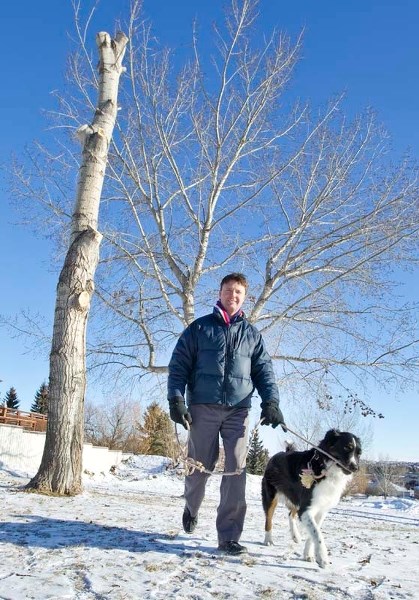Standing in the northeast corner of St. Albert's Liberton Park, Mike Gonek points at a row of eight, light-coloured hybrid poplar trees. One of the trees has been stripped of its branches and will soon be cut down completely.
He's not happy about it.
For years, hybrid poplars have been systematically replaced in the city, deemed a danger to the public due to structural issues and weak cores. But Gonek says the trees in Liberton Park look healthy and the city should reconsider its removal policy.
"It's a real shame that they are cutting down the trees," he said. "These are large trees. They will not be easily replaced."
The removal of the trees is about the city's responsibility to public safety, said Stephen Schlese, supervisor of operations at the city's public works department.
Hybrid poplars grow faster than regular poplar trees and were first planted in St. Albert in the 1970s to replace many of the native tree stands that had been removed during the city's development.
Due to their fast-growing nature, hybrid poplars suffer from weak structure, with heavy branches, multiple weakly-joined stems and a short life cycle of 15 to 30 years, Schlese said. The aging hybrids are also prone to diseases such as black canker and rotting cores.
The trees require a high level of maintenance and falling branches have caused damage to homes and cars in the past, he said. To avoid further damage, the city developed its Hybrid Poplar Removal Program in 2001 and has since scheduled the replacement of all hybrids with longer-life breeds.
"I know the residents see the big trees and they don't like us taking them down," Schlese said. "We want to keep everyone safe … and because of the work we have done we didn't have a lot of problems."
There were once 1,300 hybrid poplars in the city. Few remain. Another 50 to 60 will be cut down by the end of the year.
Schlese said the program will likely be completed by 2015. About 30 new trees will take the place of the eight poplars in Liberton Park. Schlese doesn't know yet what kind of trees will be planted.
"If you go down Giroux, we planted spruce trees there about five years ago and most are growing really well," he said.
"They are not big trees but we get the right calibre tree that will grow the best. Some people like massive trees going in but most often they don't survive because it's really hard for the roots to be re-established."
Ecosystem impact
Gonek said the trees act as a windbreak, provide shade during the summer and are likely home to a number of animals. New trees won't grow to the same height as quickly and the poplars' removal will affect the look of the park, he said.
He says the public works department told him the trees were diseased and posed a danger to the public as they may fall on walkways or paths, but he says there are no walkways in this part of Liberton Park.
Instead of removing all the hybrids, the city should only cut down the ill ones and look after the healthy ones until their time is up, he suggested.
"I am complaining because the ecosystem of this park is going to be completely altered," he said. "If we're going to be worried about trees falling on us, I think there are bigger things to worry about."
But Leah Kongsrude, the city's environment and sustainability manager, said hybrid poplars are neither native to the region nor were they cultivated to live as long as the trees in question have lived. Therefore their removal will rarely impact the local ecosystem, she said.
"Yes, animals all use trees and they are not too selective but they much prefer a large stand of natural or native poplar or white spruce like we have in our ravines," she said.
She added that replacing the trees with different and non-native species, such as elm and spruce trees, should not cause a problem as the city uses a variety of them and is careful to avoid diseases and insect infestations.
Gonek said he's also addressed his concerns with some city councillors.
Mayor Nolan Crouse said there is reason to worry about the hybrids falling down, even in less populated areas.
If the city hadn't removed so many hybrid poplars, many of them would have been blown by high winds onto people's yards and vehicles, he said. He added that a lot of the trees look healthy on the outside but are rotten on the inside. The city would not consider taking them down if they didn't cause a safety hazard, he said.
"We just made a decision several years ago to just get rid of these trees and move on with it because we just do not have the trust in these trees to remain standing," he said. "There were just too many rotten ones."




